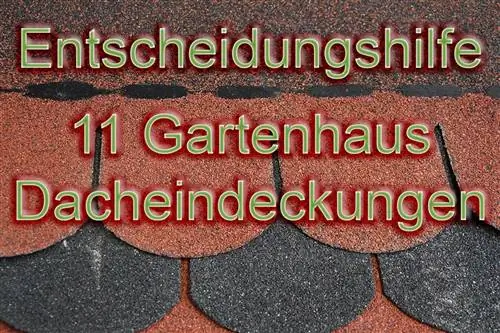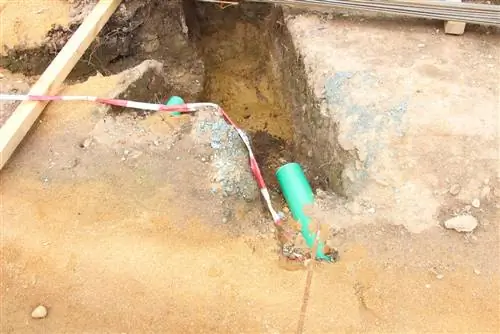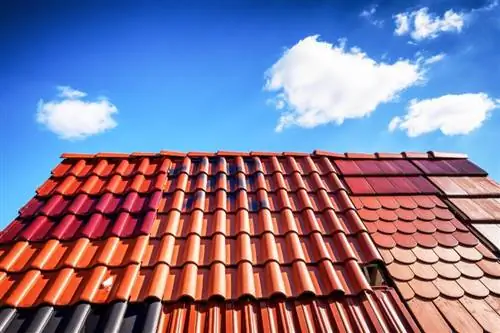- Author admin [email protected].
- Public 2023-12-17 03:39.
- Last modified 2025-01-24 12:45.
The formal language of architecture today is more diverse than ever. In addition to established styles, technical progress and new design attitudes continue to produce new elements or reinterpret familiar forms. Nowhere is this more evident than when it comes to roofs. In the following overview you will find numerous archetypes, but also sub-forms of the most defining and sometimes largest component of a building.
Gable roof
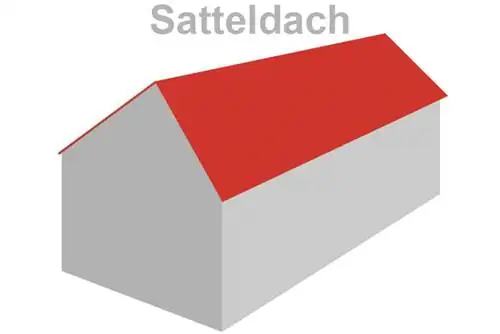
In many parts of Germany and the world, the gable roof is considered to be the established roof shape that has been used for centuries. Formed from two mostly identical roof surfaces that meet in a continuous ridge, it gives the building a clear direction. It is expressed in two opposite, triangular gable sides and two usually longer sides on which the roof surfaces run upwards towards the ridge and thus usually the center of the house.
Characteristics
Usually the same inclination of both roof surfaces, roof inclination rarely less than 10 degrees, usually from 15 degrees up to 60 degrees and more
Construction
either as a rafter roof, in which opposing rafters support each other, or as a purlin roof, in which the rafters rest on a supporting substructure made of horizontal timbers
Covering
traditionally bricks or concrete roof tiles, previously often slate or wooden shingles, today sheet metal or even greenery is also possible
Special features
Very versatile in terms of inclination, roof covering and addition of roof windows, dormers and other structures, on slopes or due to special usage requirements, they can also be found asymmetrically with an off-center ridge or different eave heights
Cross roof
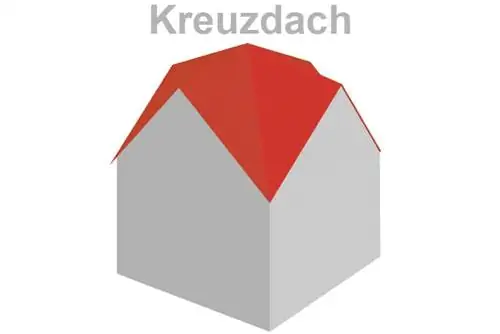
Actually, the cross roof is not one roof, but two gable roofs that cross and overlap each other at right angles. A building with a cross roof also has a visual direction, but a clear main direction is only given if one of the gable roofs dominates. With equal roofs, four equal gable sides are ultimately created.
Characteristics
Usually symmetrical design of the individual roofs, but deviations in inclination, size and ridge/eave heights are possible
Construction
usually purlin roof, rafter roof construction can only be used to a limited extent, as the rafters cannot support each other in the intersection area
Covering
like gable roof, usually brick or concrete roof tiles
Special features
common roof shape in medieval churches, usually with a dominant main roof and a subordinate transverse structure
Diaphragm
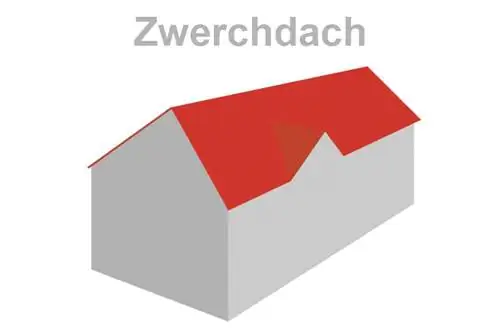
The diaphragm roof is not an independent roof of an entire building, but rather simply the roof of a structure on top of another roof shape, i.e. a dormer or a gable. The shape of this smaller, clearly subordinate roof can have the shape of numerous roofs described here, for example the gable roof, the lean-to roof or even the flat roof. Barrel roofs or hipped roofs are less common.
Construction
usually as assigned main roof
Covering
no restrictions, often adapted to the main roof, but today also often as a foil roof, with sheet metal covering or with greenery
Special features
often a flowing transition between the diaphragm roof and the side structure of a cross roof
Roof-only houses
Even roof-only houses do not actually have an independent roof shape. You usually use a classic gable roof shape. The main feature is that the side walls under the roof are completely missing or reduced to a structurally necessary minimum. All uses are accommodated around the roof space, while visually only the gable walls remain. Classically, a steep roof shape with inclinations of 45 degrees and more is chosen in order to optimize the space within the roof surfaces as much as possible.
Hipped roof
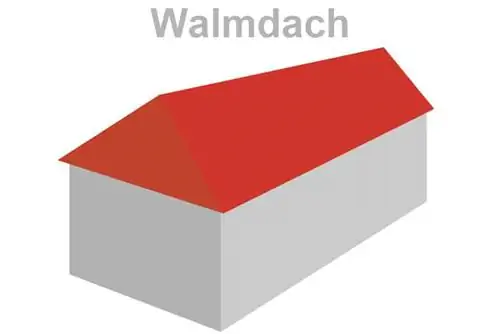
The hipped roof, which is usually found in a historical context, has the typical gable roof shape, with additional, sloping roof surfaces taking the place of the outer walls that otherwise end upwards in the gable.
Characteristics
Main roof clearly visible, hipped areas clearly subordinated, continuous eaves height on hipped areas and main roof areas
Construction
Usually as a purlin roof with a supporting substructure, as a self-supporting rafter roof is not possible in the area of the hipped areas
Covering
classically shingles, slate or bricks, but technically all gable roof coverings are possible
Special features
Typical roof shape in historical functional buildings in southern Germany, advantage of the lower external walls due to the absence of gables
Hipped roof
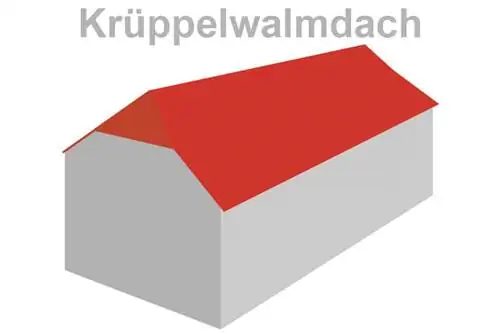
A subtype of the hipped roof is the half-hipped roof. It represents an intermediate form between the gable roof form and the hipped roof form, in which the hipped surfaces are not pulled down to the eaves of the main roof. There remain gables cut off at the top and limited by the crooked hip area.
Characteristics
pronounced main roof visible, strong subordination of the hipped areas
Construction
only possible with a supporting substructure in the form of purlins, lying or standing chairs, etc.
Covering
see hipped roof
Special features
Most common roof shape of the typical Black Forest farm, often with balconies hung under the hipped areas
hip roof
The reverse of the half-hipped roof is the so-called foot-hipped roof. Here only the “foot” of the roof is provided with a hipped surface. The upper gable triangle, however, remains visible above the hipped surface with a horizontal upper end. This roof shape can also be combined with the mansard hipped roof described below, so that the hipped surfaces run through in the area of the lower, steeper roof areas, but the upper half of the roof has a clearly visible gable design.
Tent roof

Although it initially seems like an extremely pronounced hipped roof, the tent roof represents a very unique typology that differs significantly from the gable roof. In contrast to it, it is created from four equal roof surfaces arranged perpendicular to each other, which meet at a ridge point.
Characteristics
equal roof surfaces with the same inclination and identical eaves height on all sides, no orientation of a preferred roof side, found in its pure form, especially in point buildings with a square or polygonal floor plan, roof inclinations possible as with gable roof variants
Construction
mostly with supporting central purlin or central ridge stand, self-supporting rafter construction not possible as there is no opposition between the rafters
Covering
Restrictions only due to the selected roof pitch
Special features
often found in almost square buildings with a minimal ridge, then actually an extreme form of hipped roof, but usually referred to as a tent roof due to its visual proximity
Mansard roof

If you had to describe the idea behind a mansard roof, the closest thing would certainly be to describe a gable roof, in which the roof surfaces were bent outwards to increase the volume. Ultimately, this creates a two-part roof. The upper area is formed by a flatter gable roof. In the direction of the eaves, steeper surfaces adjoin the roof surfaces. An almost full-sized floor is often achieved in the steeper part of the roof. This mansard area can therefore also have numerous windows.
Characteristics
straight roof with main direction and ridge, symmetrical structure, lower roof area with higher inclination than roof peak, lower roof areas with high inclination up to almost 90 degrees, upper area significantly flatter, similar to normal ridge roof,
Construction
Due to the two-part rafters, it is mandatory to have a load-bearing substructure, often as a purlin roof on load-bearing interior walls
Covering
Uniform covering of lower and upper roof surfaces, often tiles, but also slate and sheet metal.
Special features
Very popular roof shape, especially in the 18th and 19th centuries, today often used to give the roof visual weight and reduce the number of readable floors
Mansard hipped roof
A combination of the hipped roof and mansard roof roof shapes already described is the mansard hipped roof. In this case, the mansard roof is supplemented on the gable sides by classic hipped surfaces, which are also divided into two roof surfaces with different inclinations.
Mansard half-hip roof
Another combination of these two roof shapes is the mansard hipped roof. In contrast to the mansard hipped roof, only the upper roof area with a flatter slope is supplemented with a hipped area, while the gable walls in the steep part of the roof below remain.
pent roof

The lean-to roof is one of the simplest roof shapes. It consists of a single, inclined plane. The opening in one direction gives the building a clearly legible orientation despite the lack of ridges, while the lack of roof areas enables good use of space and the slope enables natural and technically simple drainage of rainwater.
Characteristics
Inclines of a few degrees up to 45 degrees can be found, the higher the incline, the greater the differences in the achieved room height
Construction
depending on the span either as a self-supporting slab or with medium support from an inner wall or beam
Covering
Depending on the roof pitch, foil, bitumen or sheet metal roofs, from approx. 10 degrees tiles or concrete roof tiles are also possible, often greened in new buildings
Special features
used for a long time in smaller functional buildings, only “discovered” for residential buildings and other representative objects in the modern era (approx. from the 1920s)
Staggered pent roof
A special form of the pent roof is the offset pent roof. Two pitched roofs are placed against each other and shifted relative to each other in terms of ridge height. This ultimately creates a gable roof shape, with a wall strip remaining at the “ridge” between the roof surfaces. This roof shape is often used to get natural light into a building in a central location.
Flat roof
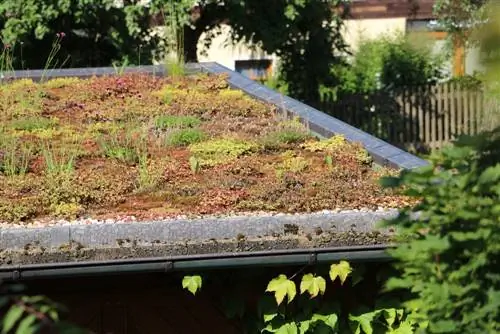
Although the flat roof is actually the simplest roof shape imaginable, it offers a lot of design freedom. The flat roof can appear to float above the building as a light disc, or it can remain invisible behind the upwardly extending external walls. As different as the appearance can be, the challenges that arise in terms of construction and detailed design are just as different.
Characteristics
Flat surface as the upper end of the building with a minimal gradient, design visible with a protruding roof edge, or possible with rising surrounding walls as an attic
Construction
Support layer made of wood or steel, alternatively reinforced concrete slab, depending on the span with or without additional support
Covering
Foil or bitumen, greenery or additional coverings made of gravel, slabs or even sheet metal possible
Special features
Despite the name, never completely flat to ensure rain drainage, at least 2% gradient required according to flat roof guidelines
barrel roof
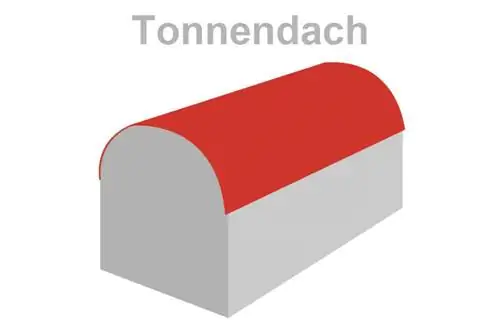
The barrel roof is a fairly new roof shape that only appeared in relevant size and number as part of industrialization and the associated steel structures. It shares numerous features with the dome, but in contrast to it has a clear direction, similar to a ridge. The barrel roof is often used in industrial buildings or infrastructure structures.
Characteristics
arched, ridgeless roof surface with two parallel eaves, no uniform roof pitch
Construction
usually as a series of supporting arches made of metal with intermediate struts, rarely made of wood or concrete, in individual cases also as a flat supporting structure made of concrete or masonry
Covering
mostly metal as a material that can be easily adapted to the curve, but classic coverings such as brick are unsuitable
Special features
Striking, rather unusual appearance, as it is primarily known from large and especially long buildings, such as train stations etc., but can still be found again and again today in individually planned residential buildings


